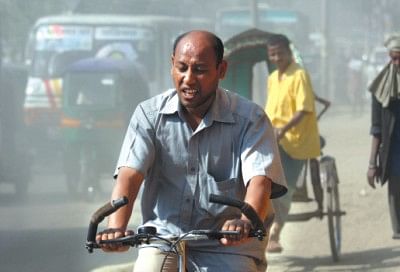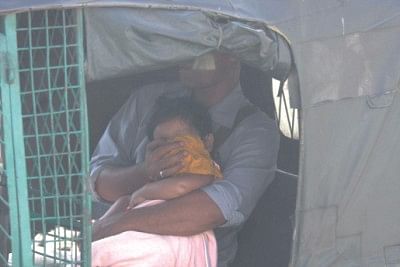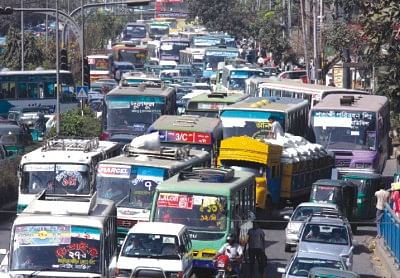|
Special Feature
A Breath of Stale Air
Lusana Anika Masrur
 Monir is a 36 year-old patient suffering from chronic bronchitis for the past two years. A father of two, he is also a traffic police under the Division of Dhaka, and has arguably one of the worst jobs in the country. Opposed by his doctor, this is a job he cannot think of resigning from despite the risks it poses for his health. “This job allows me to send my daughters to an English-medium school. I am not willing to sacrifice their future and their dreams by looking for other forms of employment that will not pay me as much,” he says. Similarly, patients suffering from bronchitis, asthma, lung cancer, and various other heart and lung diseases are on a sharp rise among Bangladesh's urban population. A significant number of these are children. These traits point fingers at a phenomenon that does not directly show its face to our often-blind society and thus remains lurking in the shadows, or rather, in the haze of its deadly smoke. Monir is a 36 year-old patient suffering from chronic bronchitis for the past two years. A father of two, he is also a traffic police under the Division of Dhaka, and has arguably one of the worst jobs in the country. Opposed by his doctor, this is a job he cannot think of resigning from despite the risks it poses for his health. “This job allows me to send my daughters to an English-medium school. I am not willing to sacrifice their future and their dreams by looking for other forms of employment that will not pay me as much,” he says. Similarly, patients suffering from bronchitis, asthma, lung cancer, and various other heart and lung diseases are on a sharp rise among Bangladesh's urban population. A significant number of these are children. These traits point fingers at a phenomenon that does not directly show its face to our often-blind society and thus remains lurking in the shadows, or rather, in the haze of its deadly smoke.
Over the last few years, we have seen a shocking boom in the number of vehicles and machines that generate carbon emissions into our once relatively breathable Dhaka-city air. Along with private cars, other modes of transport such as buses, trucks, motorbikes and CNGs have been packed into our already over-congested roads. To combat the miserly power supply, most commercial buildings and even many residential ones are increasingly using diesel-run generators. Oblivious to the concept of outsourcing, factories and cottage industries continue to mushroom in the hubs of our capital, refusing to relocate to save transportation fees. The public not paying heed to existing regulations and the lack of authorities implementing them have all contributed to our current poisonous, toxic-concentrated air. With any available open space being sold off to developers to construct cement blocks to stash more and more people, trees are being chopped off and water bodies filled. Whatever remains, is insufficient to absorb the overabundant carbon and dust in the atmosphere.
 |
PHOTO: ZAHEDUL I KHAN |
The World Health Organization (WHO) in 2005 recommended that the density of airborne particulate matter should be a maximum of 20 micrograms per cubic metre (mcm) with cities exceeding 70mcm considered highly polluted. According to the Department of Environment (DOE) in 2009, it reaches an alarming 463mcm in Dhaka between December and March! During this dry season, there is less rainfall and dust particles everywhere are allowed to roam free without the worry of anything to wash them down. Rain or shine however, this is an issue that affects every member of both our rural and urban communities, with the latter being especially at threat. Even though it is said that the carbon content in our air has reduced from the state it was in a year ago (when it was the highest in the world, worse than both Mexico City and Mumbai!), the level of air pollution in the city is three to four times higher than the national standard.
Last month, in a study conducted in Taiwan, researchers found a correlation that tied suicide rates with asthma and air pollution. The study suggests that one in 14 suicides among Taiwanese youth could have been caused by asthma, a condition that causes one in every 250 deaths in our country. The thought of killing oneself because of pollution-related health problems may not arise in the mind of an average Bangladeshi, but our carbon-rich air is still, undoubtedly, a silent killer on the loose. Most people grow so accustomed to inhaling its poison into their system on a regular basis, that they do not realize the gravity of the perils they expose themselves to. Within the population demographic, some people are more at risk than others. Unsurprisingly, it is typically people from lower working classes with a lack of knowledge, those who cannot afford air-conditioned cars and have to spend a good deal of time on the road commuting back and forth from work. Senior citizens are also at high risk because their aged and fragile bodies are more susceptible to hazards. Last but not the least, children too face high risk because their immune systems have not yet fully developed and experience illnesses as they are more exposed to open areas during peak traffic hours in the mornings and afternoons.
Fortunately, the government, private organisations, the media and the general public are becoming more and more active in not just raising awareness towards this matter, but also in taking measures to contain it. The government has taken up action-plans to improve vehicular air pollution and develop public transport. For example, The Environment Conservation Rules 1997 have been amended and the use of Catalytic Converter and Diesel Particulate Filter for Petrol and Diesel driven vehicles has been made mandatory. Less harmful than other kinds of fuel, it has also introduced Compressed Natural Gas run auto rickshaws, the usage of which has also expanded onto other forms of vehicles. Since 2003, a ban has been imposed on running vehicles that are too old. Additionally, factories have been instructed to use low sulphur content coal as fuel and install chimneys at least 120ft tall in the brick kilns. Funded by the World Bank, the DOE is currently undergoing the Clean Air and Sustainable Environment (CASE) Project to mainly address the polluting factors of urban transport and brick making by developing quality mass transit and through introducing energy efficient technology respectively. The specific objectives of this initiative are to strengthen planning foundations and monitor, regulate and implement those plans. In a seminar for concerned government officials this month arranged by DOE and the Norwegian Institute for Air Research (NILU), an agreement was made between the two parties whereby Bangladesh will receive a grant of about $1.3 million for air control monitoring and research.
However, there is a long way to go and endless room for improvement. Without any plan for decentralisation Dhaka still remains the hub of cultural, political, financial, social and any other activities in the country. Measures need to be taken to relocate educational institutes and factories outside the city. Cities in other parts of the country need to be developed to restrict the sweeping tide of urbanisation. More water bodies need to be introduced as poor drainage removes oxygen from the soil and are harmful for trees. Furthermore, open spaces need to be allocated for the sole purpose of planting trees that are crucial in absorbing air pollutants. Corporations and industries must be made more accountable for environmental responsibility. The recent introduction of the Environment Court Act-2010 promises better regulations on this behalf. Embracing a bicycle and carpool culture as that adapted in China should be extensively encouraged. Through further awareness, education and taking action by voicing our concerns through public forums, the biggest responsibility has to come from individual members of our society because only that can lead to the collective consciousness we need as a nation to combat a rising crisis before it gets more out of hand than it already is.
The Silent Killer
Farhana Urmee
Tithi leans her head against her seat and tries to move a bit as it is more than an hour she has been sitting in the same way. She lingers in this position only for a few moment as, crammed with so many passengers, there is always someone on the bus to prop himself up against her seat.
The city service bus carrying Tithi along with about 70 other passengers have not moved even an inch in the last 20 minutes. On a spur of the moment Tithi starts to loathe all the passengers in the bus, thinking life has been unduly harsh on her.
 |
Photo: STAR FILE PHOTO |
Tithi tries her best to contain the anger that by now is boiling down her soul; she sincerely tries to forget her surroundings as around her drivers unnecessarily blow horns, people habitually talk in a loud voice and ambulance carrying dying patients wait for hours in the clogged traffic.
Long before she steps into the bus, Tithi gets depressed even to think that it will not be an hour before she gets to her office at Panthapath, which ideally should not have taken her more than 30 minutes.
Every passenger in the bus has their own everyday suffering and their own way to draw a mechanism to adapt to the chaotic life that commuting in the city offers them.
“It does not make any sense that I have to spend four to five hours on the streets everyday. Yesterday I was late at work and I was late in returning home from my work,” Tithi says, afraid that she will be late for today's work too.
“You don't have enough room to sit and for the whole time you cannot move and, you have sit straight!” she says, “Only God knows how we have been commuting on these public buses.”
Tithi wipes her sweaty face with a scarf, which becomes blacker with every wipe, thanks to the grime and smog that hits her face.
Dr Asif Mujtaba Mahmud, associate professor of Sir Sallimullah Medical College Hospital, says commuters like Tithi sweat a lot and lose a large amount of salt from their body.
“It weakens a person to the extent that it destroys the strength a person needs to work in the rest of the day. One quickly gets dehydrated without having any idea of how much strength he has lost.”
As its urban landscape is gradually changing, Dhaka is bursting with energy; its citizens, too, have to commute a lot and to make matters worse the number of newcomers coming to the city has been exponentially increasing. Besides the economic loss that hangs heavily over the tender shoulder of the country's beleaguered economy, traffic jams are also seen as the prime reasons for some major ailments.
 By the time Tithi reaches office, she is quite exhausted; she throws herself into her chair and begins to go through piles of files. “At office, I feel weak and do not feel likely doing anything. And at night, I suffer from back pain.” By the time Tithi reaches office, she is quite exhausted; she throws herself into her chair and begins to go through piles of files. “At office, I feel weak and do not feel likely doing anything. And at night, I suffer from back pain.”
Traffic jam is only the many menaces, which have already made an unwilling victim of many of us. The sound pollution, such as exposure to blowing horns and loud music, often causes headaches and gradually makes a person ill tempered, Dr Mahmud says.
“Continuous traffic jam can lead to permanent ailments such as high blood pressure. Our blood pressure can increase due to prolonged stay in bad traffic if it is coupled with an exposure to heat, smoke, crowd and noise,” he says.
Doctors think that due to different types of pollutions, today's youth are quickly becoming exposed to diseases such as diabetes and cardiac complications, which traditionally are associated with old age. Nowadays a large number of young men and women are diagnosed with these fatal diseases. Mahmud says that the anxiety of reaching the destination on time and a long time exposure to heat, noise and air pollution are bringing these chronic diseases early in life. Bit by bit, the body loses its ability to resist certain common illness, frequently getting ill as their inner prevention mechanism stands on its last leg.
After daylong shuttling about on the road and a long day's work, people do not get enough time left to take a little physical exercise such as yoga, which can help the body to release the fatigue and gain some positive energy, Dr Mahmud says.
Tithi represents the people who live far away from their workplace and have to travel from the suburb to the city center. There are people who have to travel from the centre of the city to its bordering area and even outside the city everyday.
Khaleda Edib lives in Rampura and goes to work in Uttara everyday.
“If I am 10 minutes late in the morning I know it for sure that it will be impossible for me make it to the office on time and, some times, it so happens that I do not get any rickshaw to get to the bus stop,” says Khaleda.
Spending a long time on the street can cause huge stress. A person has hardly any way to get rid of the worry of whether she will be able to reach her destination in time.
An event over which people have no control and the reaction to such uncontrollable situation can give birth to immense stress. Psychologist Maleka Parvin thinks such anxiety can easily threaten a person's psychological being.
Traffic jam can also be the cause of headache, allergy (for being exposed to hit and dust), asthma, high blood pressure, back pain and many other types of physical distresses.
“Stress can permanently affect a person's mental soundness. He or she can have mood disorders (for example a person's behaviour can be gradually altered), or a person can be riddled with constant worry regarding trifling matters,” says Maleka.
On returning home, a fatigued Tithi has no energy to do the household chores. She is already dreading the next morning when she must start another long and agonising journey in Dhaka's horrible traffic that leaves even a young woman like her, feeling exhausted and ill.
Copyright
(R) thedailystar.net 2010
|

